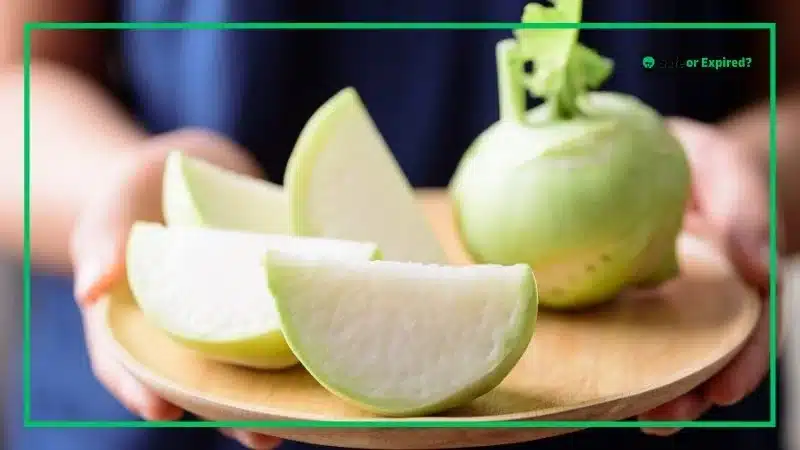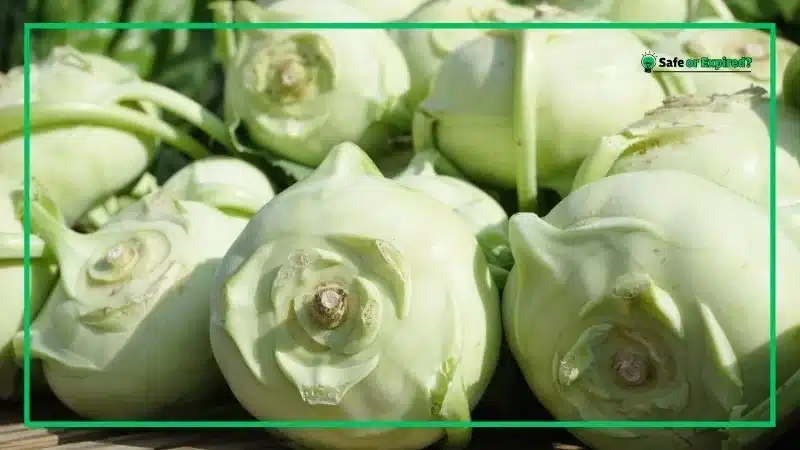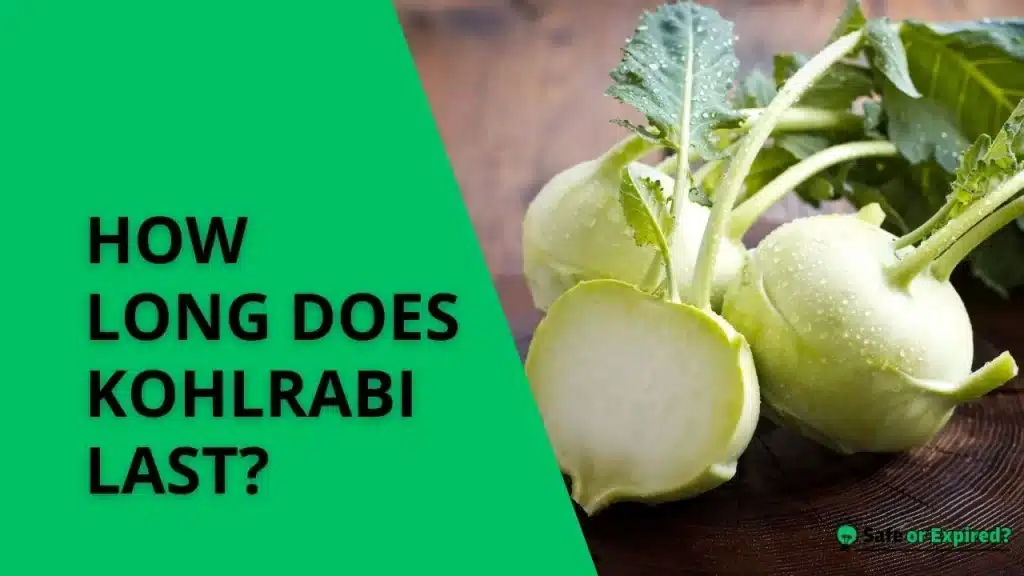“How long does kohlrabi last?” is a useful query for meal planning. Typically, it can stay fresh for 2 to 4 weeks in the refrigerator and up to 8 months in the freezer when properly prepared.
In this guide, we’ll explore the best storage methods to maximize kohlrabi’s lifespan and ensure you always have this nutritious vegetable ready for your next meal. Stick with us to uncover the secrets to keeping kohlrabi at its best!
How Long Does Kohlrabi Last?
Kohlrabi can last about 2 to 4 weeks when properly stored in the refrigerator. In the freezer, when prepped correctly, kohlrabi can last for up to 8 months, retaining its quality and nutritional value. The shelf life of kohlrabi depends on several factors, including:
- How fresh it was when purchased
- The storage method
- The storage environment.
Freshness at the time of purchase is crucial. The sooner it is stored after harvesting, the longer it will last. Environmental factors (humidity, temperature, etc.) also play a critical role. High humidity can cause moisture buildup, which may cause rot, while too-warm temperatures can speed up the degradation process.
Here’s a simple shelf life table for kohlrabi, detailing how long it typically lasts under various storage conditions:
| Storage Method | Shelf Life |
| At Room Temperature | 2-3 days |
| In the Refrigerator | 2-4 weeks |
| In the Refrigerator (cut) | 3-5 days |
| In Water (refrigerated) | 1-2 weeks |
| In the Freezer | Up to 8 months |
Now, the details.
How Long Does Kohlrabi Last in the Refrigerator?
When stored in the refrigerator, kohlrabi can last between 2 to 4 weeks. For optimal storage, place kohlrabi in a plastic bag with some air holes to maintain a bit of moisture while allowing air circulation.
The crisper drawer is ideal as it provides a consistent temperature away from the frequent changes that occur with the refrigerator door opening and closing. Always check for signs of spoilage like soft spots or mold before use.
How Long Will Kohlrabi Last in the Freezer?
Kohlrabi can last in the freezer for about 8 months if prepared properly. To freeze kohlrabi, it should first be washed, peeled, and blanched. Blanching helps retain color, texture, and nutritional value.
After blanching, dry the pieces thoroughly to prevent ice crystal formation, which can deteriorate quality. Store in airtight freezer bags or containers. You should label these bags with the date of freezing to keep track of how long they have been stored.
How Long Does Kohlrabi Last in Water?
Kohlrabi can last for about 1 to 2 weeks when stored in water, making it a useful method for extending its freshness just a bit longer than dry storage. To do this effectively, fill a container with cold water and submerge the kohlrabi stems while keeping the bulb above water.
You should also change the water every few days to prevent bacterial growth. This method is particularly beneficial if you plan to use kohlrabi gradually, as it keeps the stems hydrated and crisp.
How Long Does Cut Kohlrabi Last?
Once cut, kohlrabi’s shelf life decreases significantly due to increased exposure to air and moisture. These things can accelerate spoilage. Cut kohlrabi will last about 3 to 5 days in the refrigerator if stored properly. To store cut kohlrabi, wrap it tightly in a plastic wrap/airtight container to minimize exposure to air. Keeping it cold and sealed helps maintain its crispness and prevent it from drying out or becoming limp.

How Long Do Kohlrabi Seeds Last?
Kohlrabi seeds can last for about 3 to 5 years if stored correctly. The longevity of the seeds largely depends on the storage conditions. To maximize their shelf life, store kohlrabi seeds in a cool place away from direct sunlight.
Using an airtight container or a sealed bag can also help protect the seeds from moisture and pests. For added longevity, some gardeners store seeds in the refrigerator or a freezer, which can extend their viability by slowing down the aging process of the seeds.
How To Tell if Kohlrabi Is Bad? Top Signs
Kohlrabi is considered spoiled if it has soft spots, an off smell, or visible mold. The vegetable should be firm and the skin smooth. Discoloration or a slimy texture are also indicators that the kohlrabi has gone bad and should not be consumed.
Soft Spots and Sponginess
A fresh kohlrabi should feel firm throughout. If you press on the surface and notice any soft spots or a sponge-like texture, this is a clear sign that the kohlrabi has started to spoil. These soft areas may also look darker or discolored. When kohlrabi begins to degrade, these spots can quickly turn into rot, affecting the entire vegetable.
Here’s a picture of spot-less kohlrabi:

Off Smell
Kohlrabi typically has a mildly sweet, fresh scent. If you detect any foul or sour odors coming from your kohlrabi, it’s a strong indicator of spoilage. This off smell is a result of bacterial or fungal growth that occurs as the kohlrabi decomposes. Always trust your nose; if kohlrabi smells different from when you bought it, it’s safest to discard it.
Visible Mold
Any visible mold growth, which may appear as fuzzy or slimy patches that are white, green, or black, is a definitive sign that the kohlrabi is no longer safe to eat. Mold on one part of the kohlrabi can indicate more widespread contamination, as mold spores can easily spread throughout the interior, even if not visibly apparent on the surface.
Discoloration or Slimy Texture
Healthy kohlrabi should have a relatively uniform green or purple color. It depends on the variety, with a smooth texture. If the color turns dull or you notice any brown or black areas, this suggests decay. A slimy texture on the surface is another critical warning sign, indicating that the kohlrabi is starting to decompose and should not be consumed.
To prevent spoilage, it’s important to understand the underlying causes. Explore these in more detail with “Exploring the Causes of Food Spoilage: What You Need to Know.”
How to Store Kohlrabi to Extend Its Shelf Life? (Easy Tips)
To maximize kohlrabi’s freshness, store it unwashed in the refrigerator’s crisper drawer. For longer storage, wrap the bulbs in a damp paper towel and place them in a perforated plastic bag to balance moisture and air circulation.
Refrigeration
People often ask, “How to store kohlrabi in the refrigerator?” Storing kohlrabi in the refrigerator is the most effective method to extend its freshness. Place the kohlrabi in the crisper drawer (as it can maintain an ideal environment for fresh produce).
This compartment helps keep the kohlrabi cool and at a consistent humidity level, which is crucial for prolonging its life. Avoid washing the kohlrabi before storage, as excess moisture can accelerate spoilage.
Using a Damp Paper Towel
For kohlrabi bulbs, follow the basic food safety guidelines and wrap them in a slightly damp paper towel. Then, placing the bulbs in the fridge can help maintain the right amount of moisture around the vegetable. This technique prevents the kohlrabi from drying out.
The damp paper towel acts as a moisture barrier that keeps the kohlrabi hydrated enough without becoming waterlogged, which can lead to rot.
Perforated Plastic Bags
If you’re wondering, “How to store cut up kohlrabi,” then the answer is plastic bags. Using perforated plastic bags for storing kohlrabi allows for adequate air circulation while retaining sufficient moisture. Poke a few holes in a standard plastic bag or use commercially available perforated bags.
This setup prevents excess moisture buildup around the kohlrabi, reducing the risk of spoilage due to mold and bacteria. It’s important that the bag is not fully sealed as kohlrabi needs to breathe to stay fresh.
Keep Away from Ethylene Producers
Store kohlrabi away from ethylene-producing fruits like apples and bananas. Ethylene gas can accelerate ripening and, subsequently, spoilage in sensitive vegetables like kohlrabi.
By keeping kohlrabi separate from these fruits, you can further extend its shelf life by avoiding premature aging induced by ethylene exposure.
Moreover, there’s a lot of misinformation about how to best preserve food. Worry not; find the facts and debunk common myths with “Debunking Food Preservation Myths: The Truth Revealed.”
FAQs
Will Kohlrabi Grow Back After Harvesting?
Kohlrabi does not regrow from the same plant after harvesting the bulb. Once the main bulb is removed, the plant typically does not produce another. However, if the root and a small amount of the stem are left intact in the ground, it may sprout leaves, which can be used like collard greens. For continuous crops, it’s best to replant with new seeds or seedlings.
How to Cook Kohlrabi That’s Expired?
Cooking expired kohlrabi is not recommended, as consuming spoiled vegetables can pose health risks. If kohlrabi shows signs of spoilage such as soft spots, off smells, or visible mold, it should be discarded. However, if the kohlrabi is just past its peak but not spoiled, you can cook it by peeling, slicing, and roasting or sautéing it, which can help enhance its flavor and texture.
Is There Any Expired Kohlrabi Recipes?
There are no recipes that specifically call for expired kohlrabi because using spoiled produce is unsafe. However, slightly past-peak kohlrabi—still firm and free of mold or foul smell—can be used in recipes that involve cooking, which might include soups, stews, or baked dishes where the kohlrabi is thoroughly cooked. This can help utilize the vegetable safely before it truly spoils, ensuring it doesn’t go to waste.
Conclusion
In summary, kohlrabi can be enjoyed throughout the year if stored properly. Here are the key takeaways to remember:
- Refrigerator Storage: Kohlrabi can last 2 to 4 weeks in the fridge.
- Freezer Option: Properly prepped, kohlrabi can be frozen for up to 8 months.
- Check for Spoilage: Be vigilant for soft spots, off smells, and discoloration.
- Avoid Ethylene Producers: Store kohlrabi away from fruits that emit ethylene to prevent premature spoiling.
- Utilize Leftovers: Even slightly past-peak kohlrabi can be cooked into delicious dishes.
Now, you can extend the shelf life of your kohlrabi and enjoy its crisp, delicious flavor for as long as possible!

